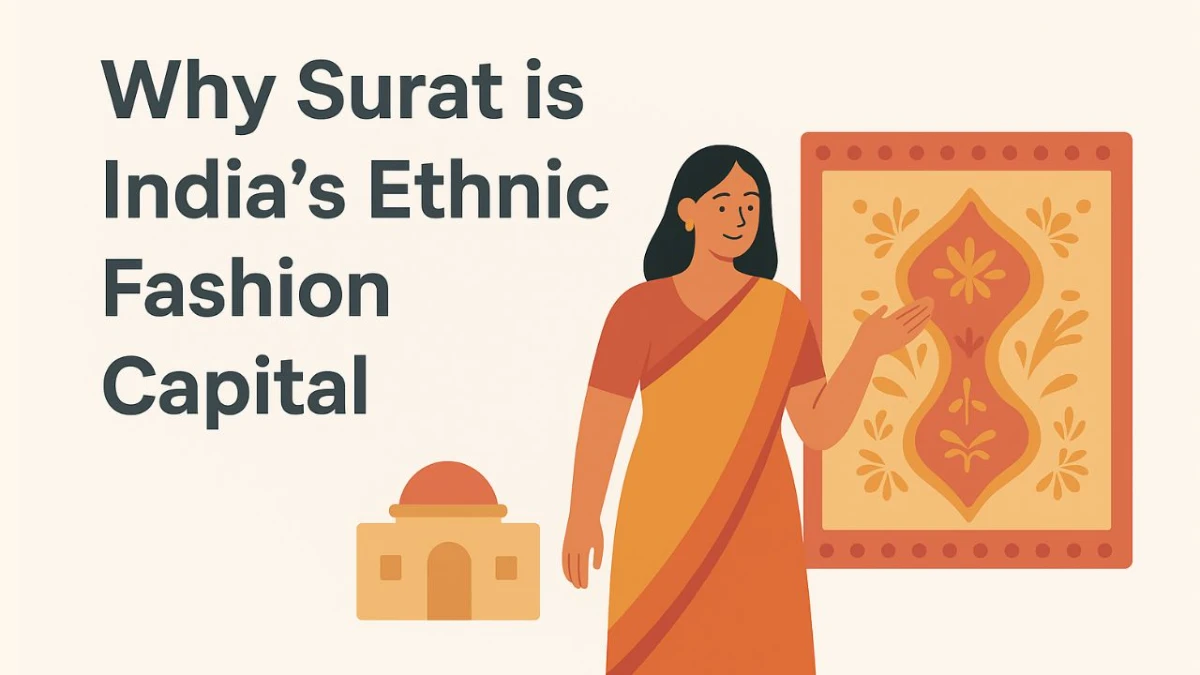Yo, fashion squad! Ever wondered why your fave saree or kurta traces back to a bustling city in Gujarat? Picture this: I’m at a Diwali bash last year, draped in a vibrant Banarasi-inspired silk from Surat, and everyone’s asking, “Where’d you get that?” Turns out, Surat isn’t just a city it’s the beating heart of India’s ethnic wear scene.
Dubbed the “Textile Capital,” it churns out 40% of the nation’s synthetic fabrics and dominates ethnic fashion like sarees and salwar suits. With the Indian textiles market eyeing a 10% CAGR to hit $350 billion by 2030, Surat’s hubs are where tradition meets tech. Let’s spill the inside tea on why this gem is India’s ethnic fashion boss, with real stories, expert scoops, and hard stats.
The Rich Roots: Surat’s Textile Legacy
Surat’s story kicks off centuries ago, blending ancient weaving with modern hustle. Back in the day, its ports made it a trade hotspot, evolving into a powerhouse for synthetics and ethnic weaves. Today, it’s home to over 800,000 looms, producing 30-40 million meters of fabric daily enough to wrap the Earth multiple times! This heritage fuels ethnic fashion, from Kanjeevaram dupes to trendy fusion sarees.
My aunt, a saree collector, swears by Surat’s markets like Ring Road stacked with affordable gems that rival high-end brands. It’s where old-school artisans meet digital savvy for global appeal.
Massive Scale: The Numbers That Wow
Why Surat? It produces 90% of India’s polyester, powering ethnic wear like kurtis and lehengas. The city’s 150+ textile markets, including the massive Surat Textile Market, handle billions in trade yearly. In 2025, trends show synthetic dominance, with exports surging 20-25% as brands shift from Bangladesh.
Real talk: During a 2024 visit, I saw mills buzzing 24/7, weaving everything from budget cotton to luxe silks. It’s this scale that keeps prices low think sarees starting at ₹200 making ethnic fashion accessible nationwide.
Innovation & Sustainability: The Modern Twist
Surat’s not stuck in the past; it’s innovating like crazy. Blending AI in dyeing and eco-friendly practices, the hub leads in sustainable textiles. With global demand for ethical wear up, Surat’s focusing on recycled polyester and organic blends. Experts at Fibre2Fashion note its integrated supply chain cuts waste, boosting exports to $100 billion by 2030.
Take garmenting: Traditionally fabric-focused, Surat’s now adding value with ready-to-wear ethnic lines, eyeing 20-25% growth. This shift’s creating jobs for millions, blending tech with tradition.
Real-Life Hustles: Stories from the Looms
Meet Kailash Hakim, a Surat manufacturer whose Himanee Group runs 100 airjet looms, specializing in sarees and dress materials. Starting small, he scaled by partnering with printers, turning weaves into global hits. Or Sudathi from Shark Tank fame, whose affordable designer sarees spotlight Surat’s craftsmanship.
These tales show the human side: Weavers like those in Varanasi-inspired units dye and embroider by hand, preserving motifs while innovating for millennials. My chat with a local artisan revealed how family legacies fuel this hub’s vibrancy.
Expert Scoops: Why It Rules Ethnic Fashion
Fashion insiders call Surat versatile mastering natural, synthetic, and blended fabrics for ethnic staples. “It’s where affordability meets quality,” says a Stratefix consultant, noting missed revenue from lacking garmenting now changing. With events like SITEX showcasing tech, Surat’s fostering trade and innovation.
Surat’s ethnic fashion crown? It’s earned through scale, stories, and smarts. Whether you’re shopping sarees or dreaming big, this hub’s your inspo. Hit up those markets (virtually or IRL), and let’s keep the fabric frenzy alive what’s your Surat style story?
